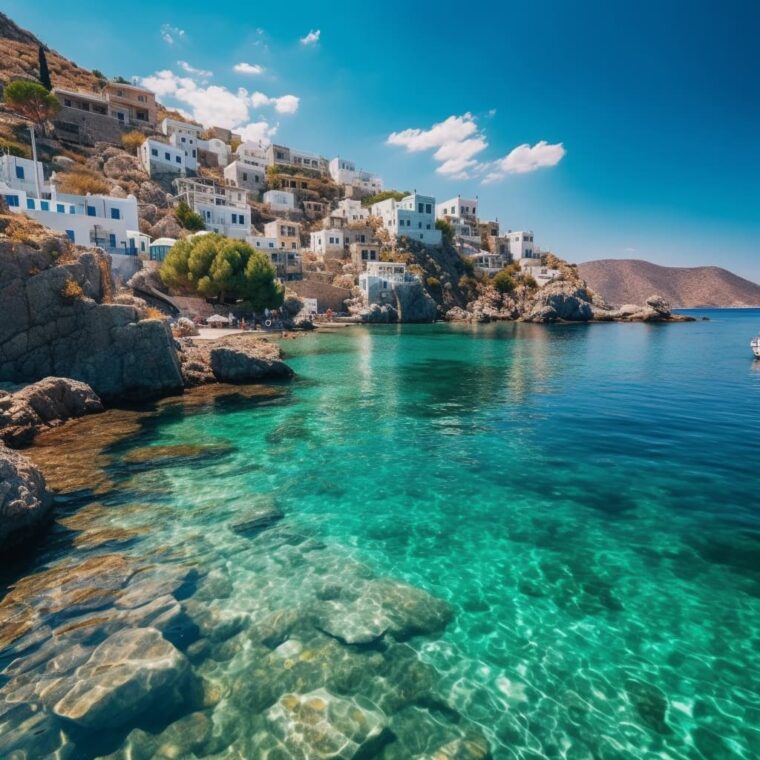Greece, a land where history whispers from ancient ruins and the Aegean Sea shimmers with an irresistible allure, stands as a premier destination for yacht charter enthusiasts. With its myriad islands, diverse landscapes, and a rich tapestry of culture, a yachting adventure in Greece offers an unparalleled journey through time and natural beauty. From the iconic whitewashed villages of the Cyclades to the lush greenery of the Ionian, and the historical grandeur of the Dodecanese, each region presents a unique charm waiting to be discovered.
This comprehensive guide delves into the most popular yacht charter destinations in Greece, providing insights into their captivating history, must-visit attractions, and suggested itineraries to help you craft the perfect Greek odyssey. Whether you seek vibrant nightlife, serene secluded coves, or a deep dive into ancient civilizations, Greece promises an unforgettable experience that blends luxury, adventure, and cultural immersion.
KEY TAKEAWAYS
- Greece offers a myriad of yacht charter destinations, each with unique landscapes, rich history, and cultural experiences. From the vibrant nightlife in Mykonos to the tranquil beaches of the Sporades Islands, there’s an island or region to cater to every preference.
- Exploring the Greek islands and regions via yacht allows for a unique and intimate exploration of their attractions. This includes iconic historical sites, cultural events, untouched beaches, fine dining experiences, and various recreational activities such as hiking, cycling, snorkeling, and scuba diving.
- The different regions and islands in Greece are ideal for various activities: the Cyclades are known for their luxury shopping and iconic sights, the Saronic Islands for charming towns and authentic dining, the Dodecanese for cultural attractions, the Ionian Islands for beautiful beaches and vibrant nightlife, and the Sporades and the regions of Peloponnese and Halkidiki for their tranquility and natural beauty.
Cyclades Islands
The Cyclades, meaning “those that encircle” (referring to the sacred island of Delos), have a rich history dating back to the Neolithic period. The Early Bronze Age saw the flourishing of the Cycladic civilization (c. 3200-1050 BCE), known for its distinctive marble figurines.
Throughout antiquity, the islands were influenced by Minoan and Mycenaean cultures, and later became part of the Athenian-led Delian League. They experienced periods of Roman and Byzantine rule, followed by Venetian control (Duchy of Naxos) and eventually Ottoman domination. The Cyclades played a role in the Greek War of Independence and have since been an integral part of modern Greece.
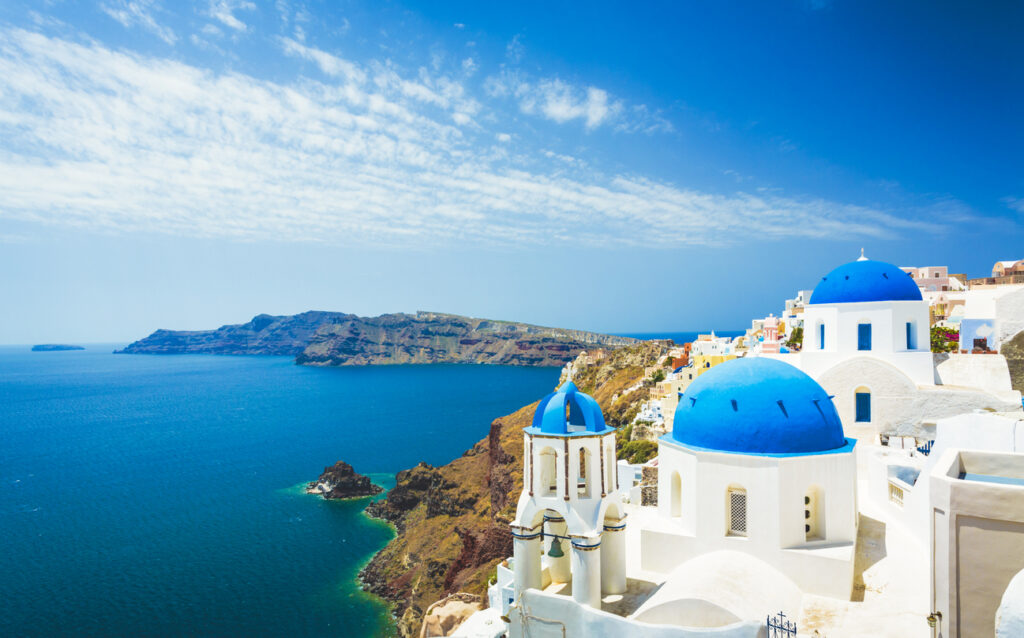
Where to Visit:
- Santorini: Famous for its breathtaking sunsets, white-washed villages perched on cliffs, and volcanic landscapes. Explore Fira and Oia, visit ancient Thera, and enjoy the unique black sand beaches.
- Mykonos: Known for its vibrant nightlife, picturesque windmills, and charming Chora (main town). Explore Little Venice, visit the archaeological site of Delos (a UNESCO World Heritage site and ancient sacred island), and relax on its beautiful beaches.
- Paros: Offers a blend of traditional Cycladic architecture, beautiful beaches, and lively towns. Explore Parikia and Naoussa, visit the Panagia Ekatontapiliani (Church of 100 Doors), and enjoy watersports.
- Naxos: The largest of the Cyclades, boasting diverse landscapes, ancient ruins, and long sandy beaches. Visit the Portara (Temple of Apollo gateway), explore the Venetian Kastro, and discover traditional villages.
- Milos: A volcanic island with a unique coastline, famous for its colorful rock formations and stunning beaches like Sarakiniko and Kleftiko. Explore the ancient city of Phylakopi and the catacombs.
Example Itinerary (7 Days – Central Cyclades):
Day 1: Athens to Kea: Depart from Athens and sail to Kea, a charming island with a rich history. Explore the main port town of Korissia and visit the ancient stone-carved lion.
Day 2: Kea to Syros: Sail to Syros, the capital of the Cyclades. Explore Ermoupoli with its Venetian architecture and visit the Archaeological Museum of Syros. Wander through the old town of Ano Syros.
Day 3: Syros to Mykonos: Head to the cosmopolitan island of Mykonos. Enjoy its vibrant atmosphere, explore Mykonos Town, and visit the iconic windmills. In the evening, experience its renowned nightlife.
Day 4: Mykonos to Delos & Paros: In the morning, take a short trip to the sacred island of Delos. Afterwards, sail to Paros. Explore Parikia or Naoussa and enjoy the island’s beautiful beaches.
Day 5: Paros to Naxos: Sail to Naxos, the largest island in the Cyclades. Visit the Portara, explore the Venetian Kastro, and relax on one of its many sandy beaches.
Day 6: Naxos to Ios: Continue to Ios, known for its lively atmosphere and stunning beaches. Enjoy swimming and sunbathing during the day, and experience the island’s nightlife in the evening.
Day 7: Ios to Santorini (or return to Athens): Sail to Santorini, marvel at its caldera views, and explore Oia or Fira. Alternatively, begin your return journey to Athens, stopping at a convenient island for the night.
Read more: Cyclades Islands Guide
Saronic Islands
Saronic Islands
The Saronic Islands, located in the Saronic Gulf near Athens, have a long and significant history, largely due to their strategic proximity to the Greek mainland. Salamis, the largest island, is famous as the site of the Battle of Salamis in 480 BC, where the Greek fleet decisively defeated the Persian navy. Aegina was a major naval power and rival of Athens in ancient times, known for its Temple of Aphaia.
Hydra gained prominence in the 18th and 19th centuries as a significant maritime and commercial center, playing a crucial role in the Greek War of Independence. These islands have historically served as important trading posts and defensive strongholds.
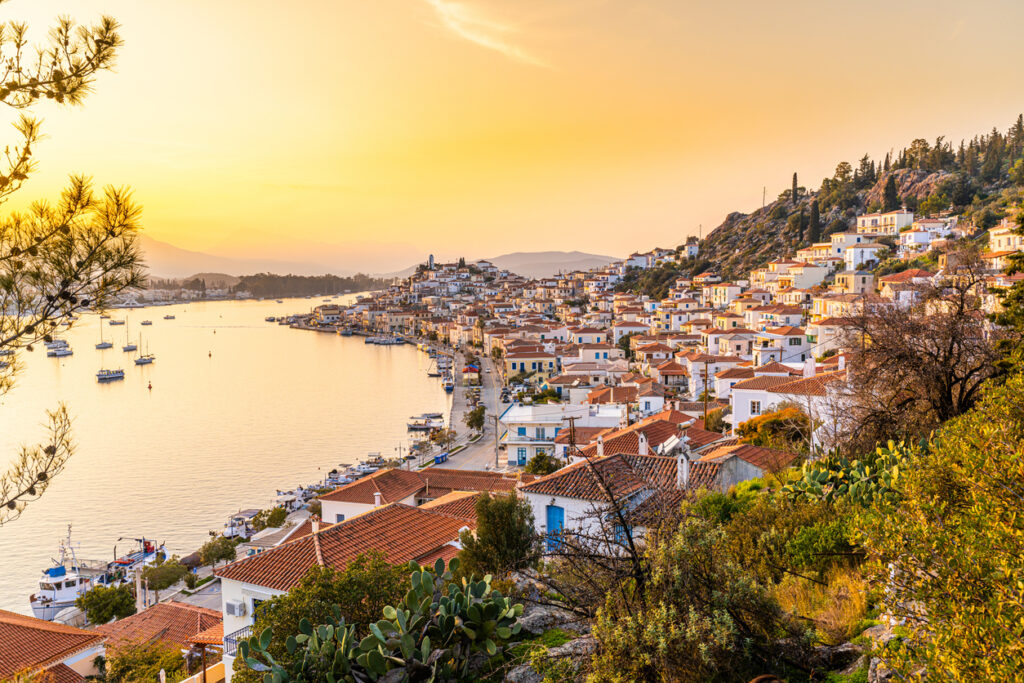
Where to Visit:
- Hydra: A car-free island renowned for its elegant stone mansions, picturesque harbor, and artistic atmosphere. Explore the Historical Archives Museum, walk along the waterfront, and enjoy the tranquil charm.
- Aegina: Known for the remarkably preserved Temple of Aphaia, a significant ancient Greek temple. Visit the archaeological site, explore Aegina Town, and sample the island’s famous pistachios.
- Poros: A verdant island separated from the Peloponnese by a narrow channel. Visit the iconic Clock Tower, explore the Lemon Forest, and enjoy the relaxed pace of life.
- Spetses: An island with a rich maritime tradition and beautiful neoclassical architecture. Explore the old harbor, visit the Bouboulina Museum, and enjoy horse-drawn carriage rides.
- Salamis: The largest of the Saronic Islands, historically significant for the Battle of Salamis. Visit the archaeological museum and explore the island’s natural beauty.
Example Itinerary (7 Days – Saronic Gulf):
- Day 1: Athens to Aegina: Depart from Athens and sail to Aegina. Explore the Temple of Aphaia and enjoy the charming town.
- Day 2: Aegina to Hydra: Sail to the car-free island of Hydra. Wander through its narrow streets, admire the architecture, and soak in the unique atmosphere.
- Day 3: Hydra to Spetses: Continue to Spetses, an island known for its maritime history and elegant mansions. Explore the town and enjoy the island’s cosmopolitan vibe.
- Day 4: Spetses to Poros: Sail to Poros. Visit the Clock Tower for panoramic views and explore the lush Lemon Forest.
- Day 5: Poros to Epidaurus (Peloponnese): Sail to the Peloponnese coast to visit the ancient theater of Epidaurus, a UNESCO World Heritage site renowned for its acoustics.
- Day 6: Epidaurus to Agistri: Sail to the small, green island of Agistri, known for its beautiful beaches and clear waters. Enjoy swimming and snorkeling.
- Day 7: Agistri to Athens: Enjoy a final swim before sailing back to Athens, concluding your Saronic Islands yacht charter.
Read moe: Saronic Islands Guide
Dodecanese Islands
The Dodecanese, meaning “twelve islands” (though comprising more than 150 islands and islets), are located in the southeastern Aegean Sea, close to the coast of Turkey. Their history is marked by various influences due to their strategic location.
They were inhabited since prehistoric times and were heavily Minoanized and later Mycenaeanized. In the Archaic period, Rhodes and Kos emerged as dominant islands, forming part of the Dorian Hexapolis. They experienced Persian rule, joined the Delian League, and later came under Roman and Byzantine control.
The Knights Hospitaller ruled Rhodes for over two centuries, leaving behind impressive medieval architecture. After Ottoman rule, the islands were occupied by Italy in 1912 and finally united with Greece in 1947.
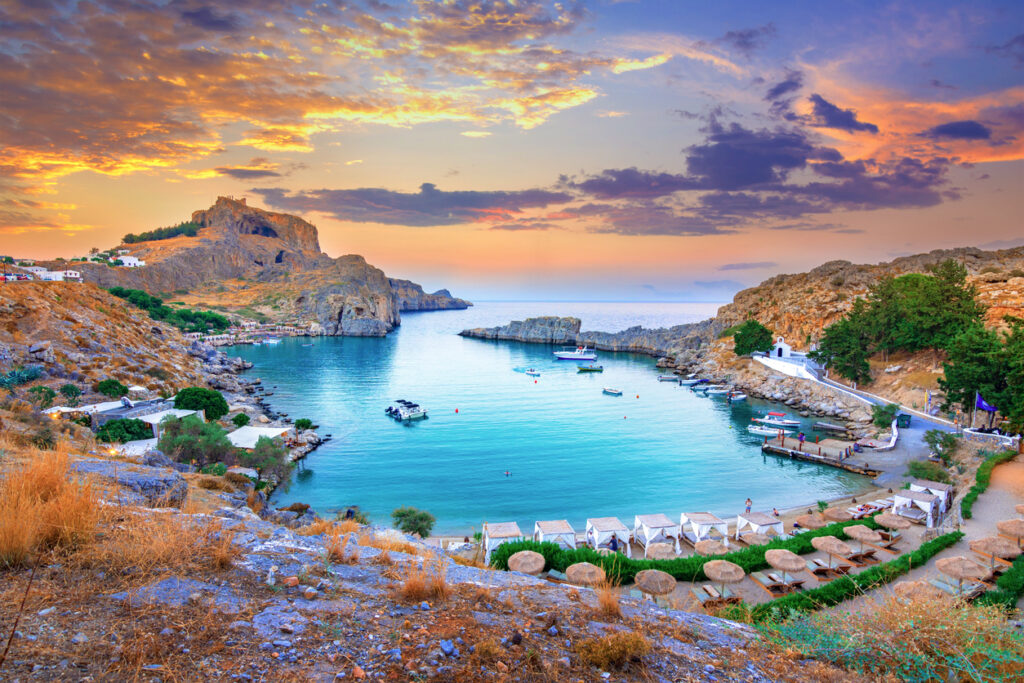
Where to Visit:
- Rhodes: The largest island, famous for its medieval Old Town (a UNESCO World Heritage site), the Palace of the Grand Master of the Knights, and the Colossus of Rhodes (one of the Seven Wonders of the Ancient World). Explore the Mandraki Harbor and the ancient city of Lindos.
- Kos: Known for its rich history, ancient ruins, and beautiful beaches. Visit the Asklepieion (ancient healing center), the Plane Tree of Hippocrates, and the medieval Castle of the Knights.
- Patmos: A sacred island, home to the Monastery of Saint John the Theologian and the Cave of the Apocalypse (both UNESCO World Heritage sites). It’s a place of pilgrimage and spiritual significance.
- Symi: A picturesque island with neoclassical architecture, colorful houses, and a charming harbor. Explore Symi Town, visit the Monastery of Panormitis, and enjoy its tranquil coves.
- Kalymnos: Famous for its sponge diving tradition and dramatic rock climbing landscapes. Explore the main town of Pothia and visit the Nautical Museum.
Example Itinerary (7 Days – Southern Dodecanese):
- Day 1: Rhodes (Mandraki Harbor): Arrive in Rhodes and embark on your yacht. Spend the day exploring the medieval Old Town, a UNESCO World Heritage site, and the Palace of the Grand Master.
- Day 2: Rhodes to Symi: Sail to the charming island of Symi. Explore its picturesque harbor with neoclassical mansions and visit the Monastery of Panormitis.
- Day 3: Symi to Nisyros: Continue to Nisyros, a volcanic island. Hike to the active volcano crater and explore the traditional villages built into the volcanic rock.
- Day 4: Nisyros to Kos: Sail to Kos, the birthplace of Hippocrates. Visit the Asklepieion, the ancient Agora, and the Castle of the Knights.
- Day 5: Kos to Kalymnos: Head to Kalymnos, known for its sponge diving history and excellent rock climbing. Explore Pothia, the island’s capital, and enjoy fresh seafood.
- Day 6: Kalymnos to Leros: Sail to Leros, a green island with a relaxed atmosphere. Visit the Castle of Panagia and explore the charming villages.
- Day 7: Leros to Patmos: Conclude your journey in Patmos, the sacred island. Visit the Monastery of Saint John the Theologian and the Cave of the Apocalypse before disembarking.
Read more: Dodecanese Islands Guide
Ionian Islands
The Ionian Islands, located off the west coast of mainland Greece, have a distinct history shaped by centuries of Venetian, French, and British rule, which set them apart from the rest of Greece that was under Ottoman domination.
This long period of foreign influence resulted in a unique cultural identity, evident in their architecture, cuisine, and language. The islands were united with Greece in 1864. Homeric epics associate Ithaca with Odysseus, though archaeological evidence for this remains debated.
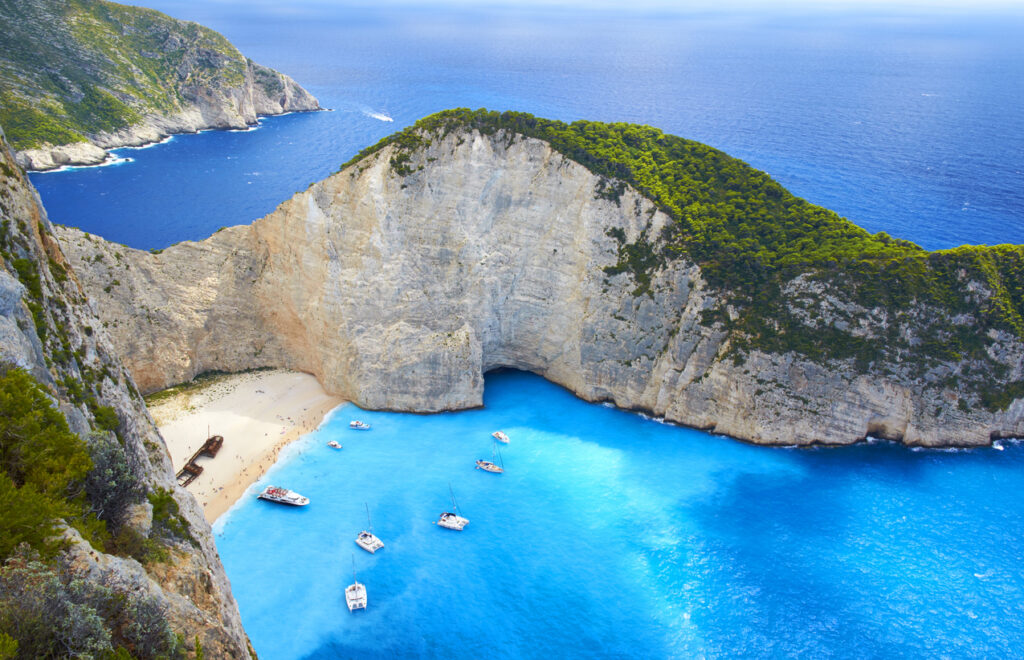
Where to Visit:
- Corfu (Kerkyra): The largest and most cosmopolitan of the Ionian Islands, known for its Venetian architecture, lush landscapes, and vibrant Old Town (a UNESCO World Heritage site). Explore the Liston, visit the Old and New Fortresses, and relax on its beautiful beaches.
- Zakynthos (Zante): Famous for its stunning Shipwreck Beach (Navagio), blue caves, and vibrant nightlife. Explore Zakynthos Town, visit the Venetian Castle, and enjoy watersports.
- Kefalonia: The largest of the Ionian Islands, offering dramatic landscapes, picturesque villages, and beautiful beaches like Myrtos Beach. Explore the Melissani Cave and Drogarati Cave, and visit the charming village of Assos.
- Lefkada: Connected to the mainland by a causeway, Lefkada is known for its incredible turquoise waters and white-sand beaches, such as Porto Katsiki and Egremni. It’s a popular destination for windsurfing and kitesurfing.
- Ithaca: The legendary home of Odysseus, a tranquil island with lush greenery and crystal-clear waters. Explore Vathy, the main town, and discover archaeological sites and secluded coves.
- Paxos & Antipaxos: Two small, idyllic islands known for their stunning turquoise waters, sea caves, and charming villages. Perfect for swimming, snorkeling, and relaxing.
Example Itinerary (7 Days – Southern Ionian):
- Day 1: Lefkada (Nidri): Arrive in Lefkada and embark on your yacht in Nidri. Spend the afternoon exploring the town and enjoying the scenic bay.
- Day 2: Lefkada to Meganisi: Sail to the tranquil island of Meganisi. Explore its charming villages like Vathy and Katomeri, and discover secluded coves for swimming.
- Day 3: Meganisi to Ithaca: Continue to Ithaca, the legendary island of Odysseus. Explore Vathy, the capital, and enjoy the peaceful atmosphere.
- Day 4: Ithaca to Kefalonia (Fiskardo): Sail to the picturesque village of Fiskardo on Kefalonia. Admire its Venetian architecture, enjoy waterfront dining, and explore nearby beaches.
- Day 5: Kefalonia (Myrtos Beach & Assos): Explore more of Kefalonia, visiting the iconic Myrtos Beach and the charming village of Assos with its Venetian castle.
- Day 6: Kefalonia to Zakynthos: Sail south to Zakynthos. Visit the famous Shipwreck Beach (Navagio) and explore the stunning Blue Caves.
- Day 7: Zakynthos to Kefalonia (or return to Lefkada): Enjoy a final swim in the clear waters of Zakynthos before sailing back to Kefalonia for disembarkation, or return to Lefkada depending on your charter arrangements.
Sporades Islands
The Sporades, meaning “scattered ones,” are an archipelago located off the east coast of mainland Greece in the Aegean Sea. Unlike the Cyclades, they are characterized by lush greenery and dense pine forests. Historically, these islands have been less central to major ancient Greek conflicts, often serving as peaceful havens.
They have been influenced by various powers throughout history, including the Byzantines and Ottomans, but largely retained their distinct character. The islands are known for their natural beauty and the National Marine Park of Alonnisos and Northern Sporades, established to protect rare marine species.
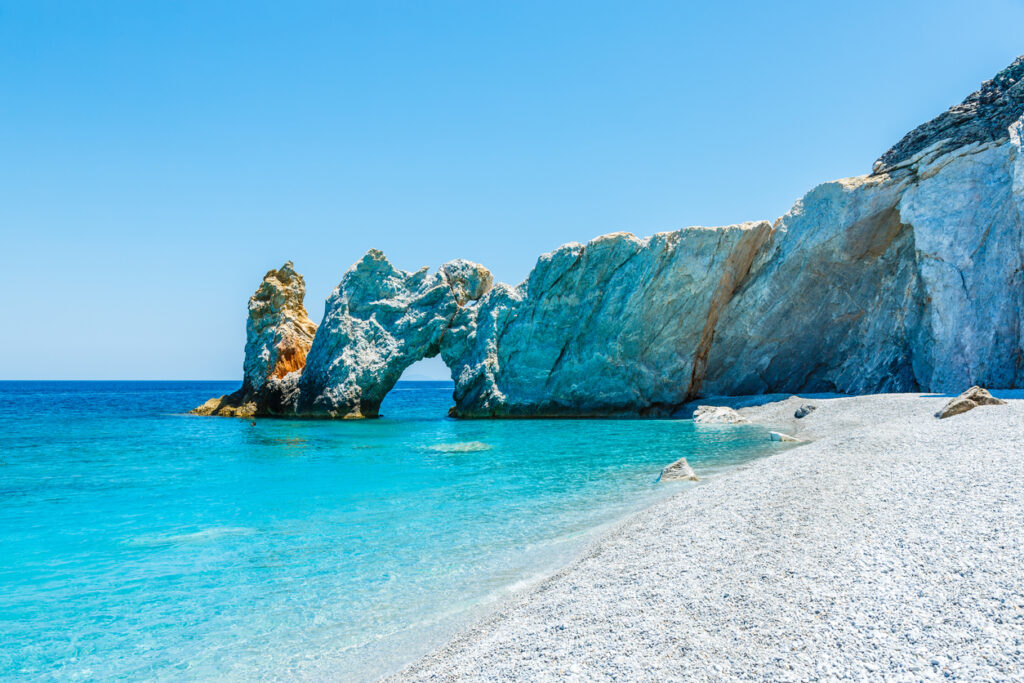
Where to Visit:
- Skiathos: The most cosmopolitan island of the Sporades, known for its vibrant nightlife, beautiful sandy beaches (like Koukounaries and Lalaria), and the charming Skiathos Town. Explore its narrow streets and enjoy the lively atmosphere.
- Skopelos: Famous for its picturesque monasteries, traditional villages, and the iconic Mamma Mia! church (Agios Ioannis Kastri). It offers a more tranquil experience with lush landscapes and crystal-clear waters.
- Alonnisos: Known for its pristine natural beauty and the National Marine Park, which is a sanctuary for the Mediterranean monk seal. Explore the Old Village (Chora), visit the Marine Park information center, and enjoy secluded beaches.
- Skyros: The southernmost island of the Sporades, offering a unique blend of traditional island life and wild landscapes. Visit Skyros Town (Chora) with its Byzantine castle, and explore the island’s distinctive architecture and local crafts.
Example Itinerary (7 Days – Northern Sporades):
- Day 1: Skiathos: Arrive in Skiathos and embark on your yacht. Spend the day exploring Skiathos Town, its charming streets, and vibrant nightlife. Relax on Koukounaries Beach.
- Day 2: Skiathos to Skopelos: Sail to Skopelos, known for its green landscapes and traditional villages. Visit Skopelos Town and climb to the Mamma Mia! church for breathtaking views.
- Day 3: Skopelos to Alonnisos: Continue to Alonnisos, the gateway to the National Marine Park. Explore the Old Village (Chora) and enjoy swimming in the pristine waters of the marine park.
- Day 4: Alonnisos (Marine Park Exploration): Dedicate the day to exploring the National Marine Park of Alonnisos and Northern Sporades. Discover secluded coves, swim in crystal-clear waters, and look out for marine life.
- Day 5: Alonnisos to Kyra Panagia: Sail to the uninhabited island of Kyra Panagia within the Marine Park. Visit the historic monastery and enjoy the untouched natural beauty.
- Day 6: Kyra Panagia to Skiathos (South Coast): Begin your return journey towards Skiathos, exploring the less crowded southern beaches of Skiathos or nearby islets.
- Day 7: Skiathos: Enjoy a final morning in Skiathos before disembarking, perhaps with some last-minute souvenir shopping or a relaxing breakfast by the harbor.
Read more: Sporades Islands Guide
Peloponnese Region
The Peloponnese, a large peninsula connected to mainland Greece by the Isthmus of Corinth, is a region steeped in ancient history and mythology. It is considered the cradle of Western civilization, home to powerful city-states like Sparta and Mycenae.
The first Olympic Games were held in Olympia in 776 BC. Throughout its history, the Peloponnese has been a battleground for various powers, including the Romans, Byzantines, Franks, Venetians, and Ottomans, each leaving their mark on its rich cultural tapestry. Its strategic location made it a crucial area for trade and defense.
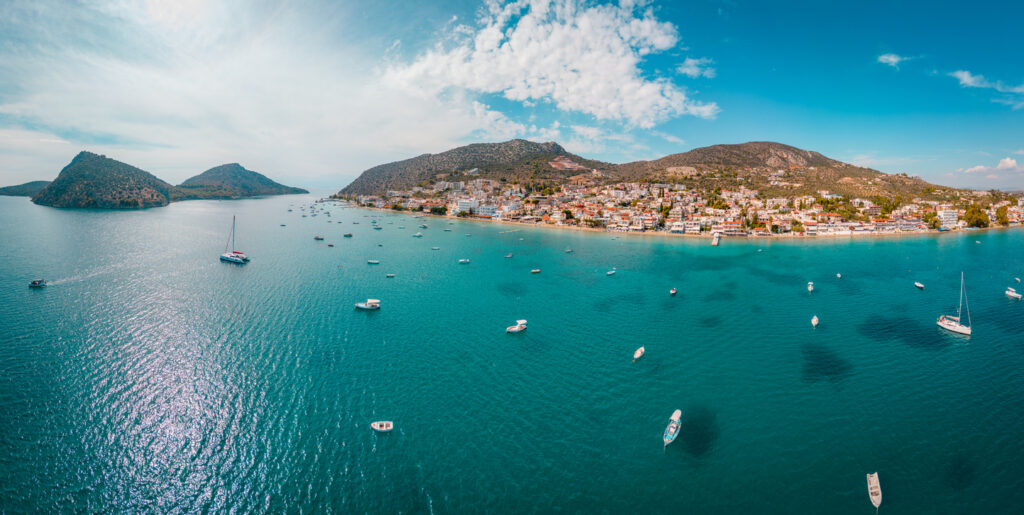
Where to Visit:
- Olympia: The birthplace of the Olympic Games, with impressive archaeological ruins including the Stadium, the Temple of Zeus, and the Temple of Hera. Explore the archaeological museum.
- Mycenae: An ancient city that was a major center of the Mycenaean civilization, a UNESCO World Heritage site. Visit the Lion Gate, the Treasury of Atreus, and the royal tombs.
- Epidaurus: Home to the ancient Theatre of Epidaurus, renowned for its exceptional acoustics and well-preserved state. Also visit the Sanctuary of Asclepius, the ancient healing center.
- Nafplio: A picturesque seaport town, the first capital of modern Greece, with Venetian and Ottoman influences. Explore the old town, climb to the Palamidi Fortress, and visit the Bourtzi castle in the harbor.
- Monemvasia: A stunning medieval fortress town built on a large rock, accessible by a single causeway. Explore its Byzantine churches, mansions, and enjoy breathtaking views of the Aegean Sea.
- Mani Peninsula: A rugged and wild region with distinctive stone tower houses, dramatic landscapes, and a unique history of independent clans. Explore traditional villages and secluded coves.
Example Itinerary (7 Days – Peloponnese & Saronic Gulf):
- Day 1: Athens to Epidaurus: Depart from Athens and sail to the coast near Epidaurus. Visit the ancient theater and the Sanctuary of Asclepius.
- Day 2: Epidaurus to Nafplio: Sail to Nafplio, a beautiful historic town. Explore the old town, climb to Palamidi Fortress, and enjoy the vibrant atmosphere.
- Day 3: Nafplio to Monemvasia: Continue south to the captivating medieval fortress town of Monemvasia. Explore its unique architecture and enjoy the stunning views.
- Day 4: Monemvasia to Elafonisos: Sail to the idyllic island of Elafonisos, known for its pristine turquoise waters and the famous Simos Beach. Enjoy swimming and relaxing.
- Day 5: Elafonisos to Gythio (Mani Peninsula): Head to Gythio, a charming port town in the Mani Peninsula. Explore the rugged beauty of Mani, its tower houses, and traditional villages.
- Day 6: Gythio to Hydra: Sail back towards the Saronic Gulf, stopping at the car-free island of Hydra. Enjoy its unique charm and artistic ambiance.
- Day 7: Hydra to Athens: Enjoy a final morning in Hydra before sailing back to Athens, concluding your Peloponnese and Saronic Gulf yacht charter.
Read more: Peloponnese Region Guide
Halkidiki Region
Halkidiki, a three-pronged peninsula in Northern Greece, has a history dating back to ancient times. It was colonized by Greeks from Euboea in the 8th century BC, and the ancient city of Stageira was the birthplace of Aristotle.
The region played a role in the Peloponnesian War and later became part of the Macedonian Kingdom under Philip II. During the Byzantine era, Mount Athos, the easternmost ‘finger’ of Halkidiki, became a significant monastic center. The peninsula was incorporated into the Greek Kingdom after the Balkan Wars in 1912. In recent decades, Halkidiki has transformed into a popular tourist destination, known for its beautiful beaches and natural landscapes.
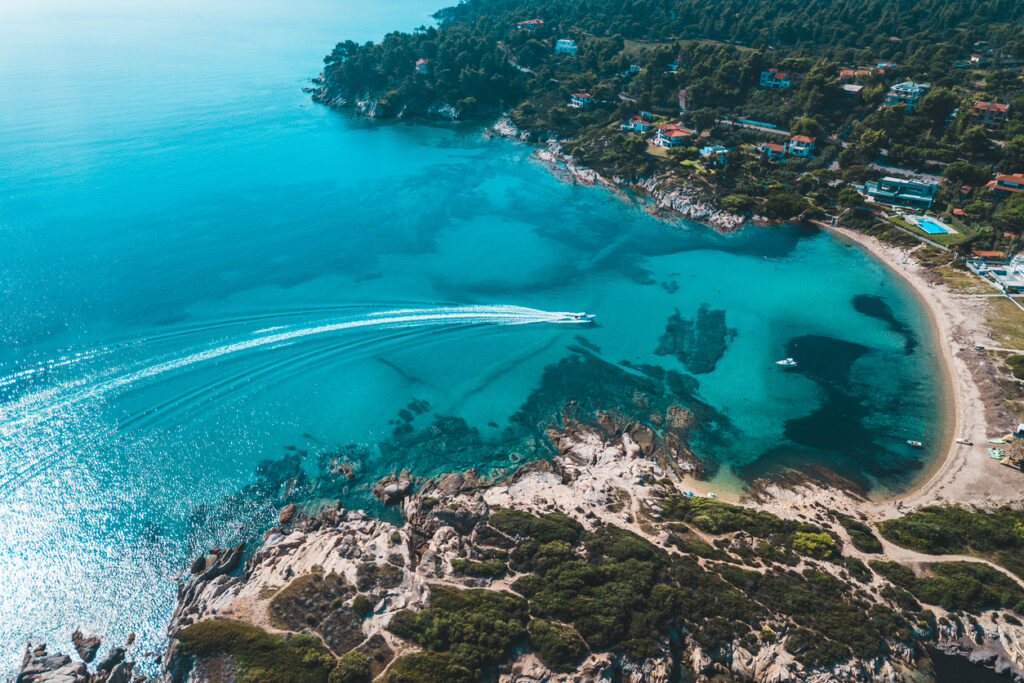
Where to Visit:
- Kassandra: The westernmost and most developed ‘finger,’ known for its lively resorts, organized beaches, and vibrant nightlife. Popular towns include Kallithea, Hanioti, and Pefkochori.
- Sithonia: The middle ‘finger,’ offering a more tranquil and natural experience with secluded coves, pine forests, and picturesque villages. Explore Neos Marmaras, Vourvourou, and enjoy the stunning beaches.
- Mount Athos: The easternmost ‘finger,’ a unique monastic state with a rich spiritual history. Access is restricted, but yacht charters can admire the monasteries from the sea. (Note: Access to Mount Athos is highly restricted and typically not part of a standard yacht charter itinerary for tourists).
- Ammouliani Island: The only inhabited island of Halkidiki, offering beautiful beaches and a relaxed atmosphere. It’s a great spot for swimming and enjoying fresh seafood.
- Ancient Stageira: The birthplace of Aristotle, an important archaeological site for history enthusiasts.
Example Itinerary (7 Days – Halkidiki):
- Day 1: Nea Moudania (Kassandra): Arrive in Nea Moudania and embark on your yacht. Explore the town and enjoy the local atmosphere.
- Day 2: Nea Moudania to Kallithea (Kassandra): Sail along the coast of Kassandra, stopping at popular beaches like Sani. Anchor in Kallithea and enjoy its lively evening scene.
- Day 3: Kallithea to Neos Marmaras (Sithonia): Sail to Sithonia, known for its natural beauty. Explore Neos Marmaras, a charming town with a picturesque harbor and the Porto Carras Grand Resort.
- Day 4: Neos Marmaras to Vourvourou (Sithonia): Continue exploring Sithonia, sailing to the beautiful Vourvourou bay. Discover the Diaporos island complex with its turquoise waters and secluded coves.
- Day 5: Vourvourou to Ammouliani Island: Sail to Ammouliani, the only inhabited island of Halkidiki. Enjoy its pristine beaches and tranquil environment.
- Day 6: Ammouliani to Ouranoupolis (Mount Athos area): Sail towards the Mount Athos peninsula. While direct access to the monastic state is restricted, you can admire the monasteries from a distance by sea. Explore Ouranoupolis, the gateway to Mount Athos.
- Day 7: Ouranoupolis to Nea Moudania: Begin your return journey to Nea Moudania, enjoying the scenic coastline one last time before disembarkation.
| Region/Island Group | Popular Destinations | Highlights | Activities |
| Cyclades Islands | Mykonos, Santorini, Paros, Naxos | Historical significance, luxury dining, and shopping | Restaurants, beach clubs, sightseeing |
| Saronic Islands | Hydra, Spetses, Aegina, Poros | Historical significance, charming towns | Beaches, cycling, hiking, dining |
| Dodecanese Islands | Rhodes, Kos, Simi | Historical significance, cultural attractions | Sightseeing, swimming, snorkelling |
| Ionian Islands | Corfu, Zakynthos, Zante, Ithaca, Kefalonia | Historical significance, vibrant nightlife | Beaches, sailing, scuba diving, nightlife |
| Sporades Islands | Alonissos, Skiathos, Skopelos, Skyros | Historical significance, pristine nature | Relaxation, beaches |
| Peloponnese Region | Corinth, Patras, Kalamata, Nafplion | Historical significance, ancient culture | Sightseeing, beaches, mooring |
| Halkidiki Region | Kassandreia, Sani | Historical significance, untouched beaches | Cultural sights, swimming, snorkeling |
| Sub-Regions | Mykonos, Vouliagmeni, Santorini, Hydra, Milos | Variety of attractions | Range of activities tailored to each sub-region |
Popular Sub-Regions in Greece
Mykonos Yacht Charters
Mykonos is an unrivaled charter destination in the Cyclades, known for its vibrant nightlife, stylish beach clubs, and a unique blend of traditional and contemporary Greek culture. Visitors can explore hidden coves, relax on sandy beaches, or visit iconic windmills.
See Mykonos yacht charter options.
Santorini Yacht Charters
Santorini, famous for its white-washed buildings and blue-domed churches, is a jewel of the Aegean Sea. Yacht charters can explore the volcanic islands, watch stunning sunsets from Oia, or sample exquisite wines from local vineyards.
See Santorini yacht charter options.
Vouliagmeni
Vouliagmeni, meaning “sunken” in Greek, is a prestigious seaside suburb of Athens, part of the Athenian Riviera. Its history is tied to ancient Greek mythology, with legends connecting it to Apollo. Archaeological findings in the area, including Neolithic and Bronze Age foundations and a 5th-century BC outpost, indicate early human habitation. In classical times, it was the Athenian deme of Aixōnídes Halaí. More recently, it has developed into an upscale area known for its natural beauty, luxurious amenities, and high real estate values.
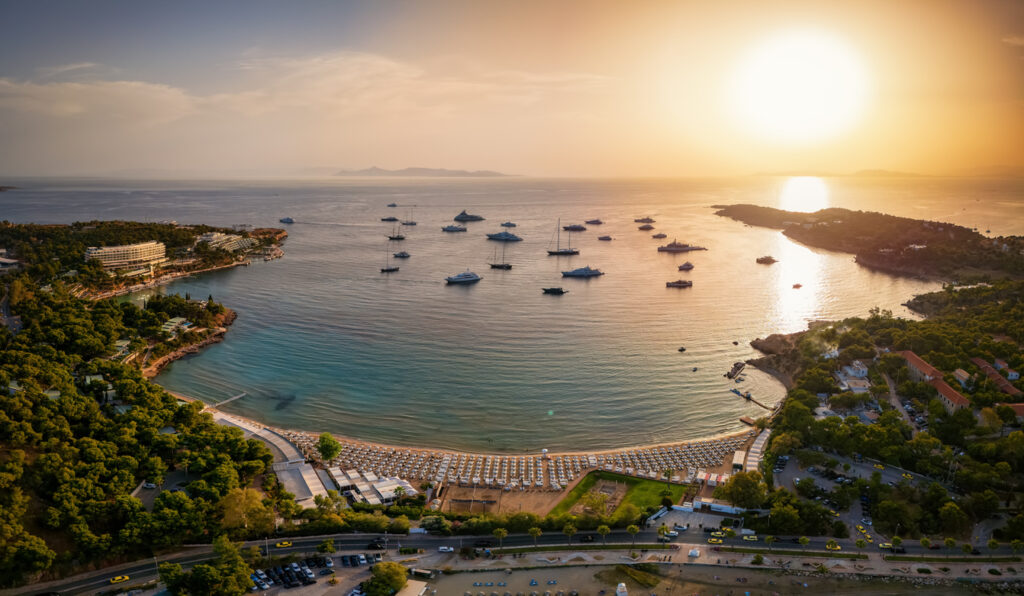
Where to Visit:
Lake Vouliagmeni: A unique natural thermal lake with brackish waters, fed by underground currents. It’s a popular year-round spa and a natural wonder, known for its therapeutic properties.
Astir Beach: One of the most famous and luxurious organized beaches in Athens, offering high-end services and clear waters. It’s part of the Astir Palace complex.
Vouliagmeni Marina: An upscale marina that serves as a hub for luxury yachts, offering a sophisticated atmosphere with waterfront restaurants and cafes.
Temple of Apollo Zoster: The ruins of this ancient temple can be found within the Astir Hotel beach area, offering a glimpse into the region’s mythological past.
Example Itinerary (Day Trip from Athens):
Morning: Sail to Vouliagmeni: Depart from an Athens marina (e.g., Alimos or Flisvos) and enjoy a short sail along the Athenian Riviera to Vouliagmeni. Anchor near the Vouliagmeni Marina or a suitable swimming spot.
Mid-day: Explore Lake Vouliagmeni & Astir Beach: Visit the natural thermal Lake Vouliagmeni for a relaxing swim or therapeutic dip. Afterwards, enjoy the luxurious amenities and clear waters of Astir Beach.
Afternoon: Waterfront Dining & Leisure: Have lunch at one of the upscale waterfront restaurants in Vouliagmeni. Enjoy a leisurely stroll around the marina or explore the charming streets of the suburb.
Evening: Return to Athens: Enjoy the sunset as you sail back to Athens, concluding your luxurious day trip to Vouliagmeni.
Milos
Milos, a volcanic island in the Cyclades, boasts a rich and often dramatic history. Its strategic location and abundant obsidian (a volcanic glass used for tools) made it a crucial center of early Aegean civilization as far back as 15,000 years ago. Milos was a significant Minoan and Mycenaean outpost. During the Peloponnesian War, Milos, a Dorian state, attempted to remain neutral but was brutally besieged and conquered by Athens in 416 BC, an event famously recounted by Thucydides. The island later came under Roman, Byzantine, and Ottoman rule. Milos is perhaps most famous for the discovery of the Venus de Milo statue in 1820, now housed in the Louvre Museum.
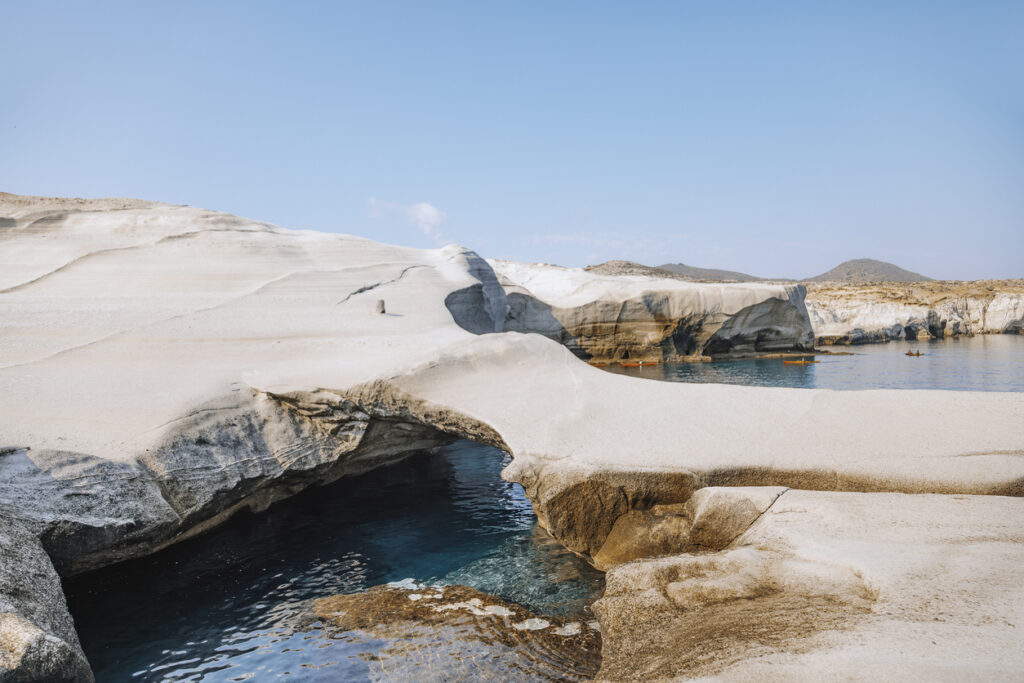
Where to Visit:
Sarakiniko Beach: A unique lunar-like landscape formed by white volcanic rock formations, creating a surreal and stunning beach environment. Perfect for photography and swimming.
Kleftiko (Pirate Fjord): Accessible only by boat, this iconic spot features impressive white rock formations, sea caves, and crystal-clear turquoise waters. Ideal for swimming, snorkeling, and exploring.
Plaka: The charming capital of Milos, perched on a hill with traditional Cycladic architecture, narrow alleys, and panoramic views. Visit the Venetian Castle and the Archaeological Museum.
Catacombs of Milos: Early Christian catacombs, dating back to the 1st-5th centuries AD, offering a glimpse into the island’s ancient past and early Christian communities.
Ancient Theatre of Milos: A well-preserved Roman theater with stunning views of the sea, still used for cultural events today.
Pollonia: A picturesque fishing village on the northeastern tip of the island, known for its fresh seafood tavernas and relaxed atmosphere.
Example Itinerary (3-4 Days – Milos Exploration):
Day 1: Arrival & Plaka Exploration: Arrive in Milos (e.g., Adamas port) and embark on your yacht. Sail to a nearby anchorage or marina. Spend the afternoon exploring Plaka, the island’s capital, with its charming alleys, Venetian castle, and archaeological museum.
Day 2: Sarakiniko & North Coast: Sail to Sarakiniko Beach for a unique swimming and sunbathing experience amidst its lunar landscape. Explore other northern beaches and coves, enjoying the volcanic scenery.
Day 3: Kleftiko & South Coast: Take a boat trip to Kleftiko, exploring its sea caves and swimming in its turquoise waters. Continue along the south coast, discovering hidden beaches and enjoying the dramatic coastline.
Day 4: Ancient Sites & Departure: Visit the Catacombs of Milos and the Ancient Theatre. Enjoy a final swim or meal in Pollonia before disembarking and departing from Milos.
Greece, with its unparalleled blend of ancient history, vibrant culture, and breathtaking natural beauty, offers an extraordinary canvas for yacht charter adventures. From the iconic Cyclades to the serene Sporades, the historical Dodecanese, the lush Ionian, the mythical Peloponnese, and the pristine Halkidiki, each region presents a unique charm and a wealth of experiences. Whether you seek the lively nightlife of Mykonos, the tranquil coves of Alonnisos, the historical grandeur of Rhodes, or the dramatic volcanic landscapes of Milos, a yacht charter provides the ultimate freedom to explore these diverse treasures at your own pace.
By combining luxury, flexibility, and the opportunity for deep cultural immersion, a Greek yacht charter promises not just a vacation, but a journey of discovery that will leave you with cherished memories for a lifetime. Embark on your Greek odyssey and let the azure waters guide you to an unforgettable experience.
Explore yacht charter Greece options.
FAQs
The best time for a yacht charter in Greek Islands is from late April to mid-October. The weather during these months is typically sunny and warm with stable winds, perfect for sailing.
Chartering a yacht in Greek Islands typically involves choosing a yacht broker or a charter company, selecting a type of yacht, determining the length of the trip, and then finalizing the itinerary.
The most popular destinations for yacht charters in Greece include the Cyclades, Saronic Islands, Dodecanese Islands, Ionian Islands, Sporades Islands, the Peloponnese region, and the Halkidiki region. Within these regions, Mykonos, Santorini, Hydra, and Milos are particularly popular.
In Greece, to charter a yacht without a skipper, one of the crew members must hold a valid sailing license. Alternatively, you can hire a skipper along with your yacht charter.
Lightweight clothing, swimwear, a hat, sunscreen, and sunglasses are essential for a yacht charter in Greece. Also, consider packing some warmer clothes for cooler evenings and a rain jacket in case of unexpected showers.
Greece offers a variety of yachts for charter, including motor yachts, sailing yachts, catamarans, gulets, and luxury superyachts.
Greece has a Mediterranean climate with warm and dry summers. The wind conditions vary across the country, with the Meltemi wind affecting the Aegean Sea and lighter winds in the Ionian Sea.
Yes, exploring Greek islands is one of the main attractions of a yacht charter in Greece. Each island group offers unique landscapes, historical attractions, and cultural experiences.
Yes, Greece is considered a safe destination for yacht chartering. The country has modern marinas, professional charter services, and the seas around the islands are generally safe for navigation.
Yes, yacht charters in Greece are suitable for families. Many yachts come equipped with family-friendly facilities, and the diverse range of activities available on the islands cater to all age groups.

